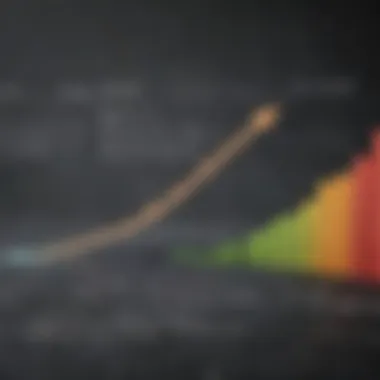Examining Trickle Down Economics: Effectiveness and Critiques


Intro
Trickle down economics is a concept that has stirred up heated debates among economists, policymakers, and everyday folks. It is essentially the idea that policies benefiting the wealthy will seep down to the rest of the population, boosting overall economic prosperity. Many would argue that when those at the top of the economic ladder thrive, they invest more in business ventures, create jobs, and, in theory, elevate the living standards of the wider community. Still, others challenge this notion, presenting evidence that suggests the wealth does not trickle down as expected, leading to increased inequalities instead.
One has to wonder: does this theory really work? And if so, at what cost to the working class? Understanding the pulse on this economic philosophy requires us to peel back layers of historical context, theoretical considerations, and practical ramifications. This article aims to lay these components bare, providing a comprehensive dialogue around trickle down economics. We'll walk through its principles, review critiques from various economic scholars, and assess its implications within today's financial landscape.
Here, we analyze everything from the foundational terminology that fuels discussions of investment strategy, to the critical advice that might bridge the gap between theory and real-world application. By the end of this deep dive, readers will gain a nuanced perspective on whether trickle down economics serves as a viable framework for economic reform, or if it merely paves a route to wider disparity.
Understanding Trickle Down Economics
Understanding trickle down economics is crucial for anyone looking to navigate the murky waters of modern economic discourse. This concept cuts to the heart of fiscal policy and its impacts on different economic strata. At its core, this theory posits that benefits given to the affluent will eventually flow down to the less fortunate in society, stimulating growth and improving living standards across the board. Thus, grasping the fundamentals of this approach is essential for investors, financial advisors, and students alike.
By delving into the intricacies of trickle down economics, one can uncover the potential advantages it offers, such as increased investment and innovation. On the flip side, it also brings forth contentious debates regarding income inequality and wealth distribution. Understanding these dynamics is not only beneficial but necessary, as they inform discussions on fiscal policy and socio-economic impact.
Definition and Overview
Trickle down economics suggests that policies favoring the wealthy — often in the form of tax cuts — can lead to overall economic growth. Proponents argue that when the rich have more capital, they invest in businesses, hire more employees, and create more jobs; this subsequently raises income levels for everyone. However, critics argue that these benefits are not always distributed equally, leading to widening income gaps.
Historical Origins
Emergence in the Early 20th Century
The roots of trickle down economics can be traced back to the early 20th century. During this time, economic theories were evolving, particularly in response to the impacts of the Industrial Revolution. The underlying idea was that fostering an environment where businesses could flourish would ultimately benefit society as a whole. The key characteristic of this emergence is its fundamental belief in the capacity of the market to self-correct and generate broad-based prosperity. This perspective is often seen as appealing because it shifts the focus from direct government intervention to the potential of free-market dynamics.
A unique feature of this early model was the emphasis on minimal regulation, allowing markets to operate freely. The advantages of this approach include fostering innovation, while its disadvantages may encompass the neglect of socio-economic welfare among the lower classes. Therefore, understanding this early context is pivotal when analyzing the subsequent developments of trickle down economics.
The Reagan Era and Its Impact
The Reagan era marked a watershed moment in the implementation and popularization of trickle down economics. During the 1980s, President Ronald Reagan advocated for sweeping tax reforms aimed primarily at corporations and high-income earners. The central idea was that by reducing tax burdens, wealth would trickle down through investment and job creation. This period is characterized by a significant neoliberal shift in economic policy, promoting deregulation alongside tax cuts.
What makes this era particularly relevant for our discussion is the legacy it left behind. While supporters lauded the economic growth and job creation during this time, critics contend it exacerbated income inequality. This declared shift towards a more market-driven approach also introduced a unique feature in the socio-economic landscape, which offered the chance to evaluate the long-term outcomes of such economic policies. The subsequent rise in wealth concentration posed challenges that are still being grappled with today.
Core Principles of Trickle Down Economics
Understanding the core principles of trickle down economics is vital for anyone looking to grasp this controversial economic approach. These principles serve as the foundation for policies and theories that purport to stimulate growth by leveraging benefits bestowed upon wealthier individuals and corporations. The crux of this argument lies in the belief that by enhancing the circumstances of the affluent, economic prosperity will gradually seep down to the broader population. This section delves into two integral components of trickle down economics: supply-side economic theory and the implementation of tax cuts for high-income earners.
Supply-Side Economic Theory
At the heart of trickle down economics is the supply-side economic theory. This theory promotes the idea that tax cuts, deregulation, and policies favoring business can spur investment, ultimately driving job creation and growth. It's like the notion that if you water the top of the plant, the roots will eventually drink up.
Key aspects of supply-side economics include:
- Tax Incentives: It argues that such incentives will encourage businesses to reinvest profits back into their operations, leading to capital expansion.
- Economic Expansion: The idea that if businesses thrive, the influx of resources will create more jobs, which in turn will raise personal incomes.
- Increased consumption: With people earning more, spending increases, reviving the economy more broadly.
Critics, however, often raise eyebrows at these assumptions. They argue that wealth does not necessarily trickle down, and the rich often accumulate resources without a net positive impact on lower income demographics. A key takeaway from this is that the actual mechanisms through which benefits flow through the economy are worth examining closely.
Tax Cuts for High-Income Earners
The most identifiable aspect of trickle down economics revolves around tax cuts for high-income earners. The premise here is that by reducing the tax burden on those with the most disposable income, they will have greater potential for investing in businesses and creating jobs.


Here are some points that capture the essence of this principle:
- Increased Capital for Businesses: Tax savings are often funneled back into business ventures or expansions, with the idea that this will optimistically lead to hiring and wage increases.
- Trickle Down Exaggeration: There is an argument that a reduction in taxes for the wealthy disproportionately benefits them, often leading to increased wealth concentration without corresponding support to the lower economic tiers.
- Historical Evidence: Observations from various economic events, particularly during the Reagan era, suggest that tax cuts did not necessarily correlate with expected economic improvements, raising questions about the true impact of such tax policies.
"In practice, tax cuts for the wealthy often end up financing an increase in luxury goods rather than a wave of new jobs."
Critics argue that while the affluent garner financial relief, tangible benefits may remain within the upper echelons of society, seldom reaching those in greater need. Thus, the effectiveness of tax cuts continues to stir debate among economists and policymakers alike. Understanding these principles poses essential questions about the economic dynamics at play and helps inform future policy decisions.
Evaluating Economic Growth and Wealth Distribution
Evaluating economic growth alongside wealth distribution is crucial in understanding the full impact of trickle down economics. This perspective allows us to see how policies designed to enhance economic prosperity affect the wider population. It provides a lens through which policies can be scrutinized for their effectiveness in fostering an equitable society.
Understanding the nuances of economic growth involves examining various indicators like GDP and employment trends, while wealth distribution offers insight into how economic benefits are shared among different societal groups. Without this comprehensive analysis, the effectiveness of trickle down economics remains ambiguous.
Measuring Economic Growth
GDP Growth Rates
Measuring economic growth through GDP growth rates offers a straightforward approach to assess the economy's performance. The Gross Domestic Product captures the total value of goods and services produced over a specific time. A vital characteristic of GDP growth rates is their ability to reflect broad economic health, making it a favored choice for analyses in this article.
However, the use of GDP as a sole indicator has its drawbacks. While high GDP growth might suggest a thriving economy, it can mask underlying issues like rising inequality. This highlights a unique feature of GDP growth: it doesn’t account for how that growth is shared among the population. Therefore, while it can paint an optimistic picture, it requires complementary data to provide a complete understanding of economic conditions.
Employment Trends
Employment trends provide another essential lens through which we can evaluate economic growth. This aspect highlights the connection between job creation and income levels, showing if the benefits of economic growth are trickling down to the average worker. A key characteristic here is the correlation between low unemployment and robust economic growth, making employment metrics a popular choice for economists assessing the efficacy of trickle down policies.
However, examining employment trends also reveals a unique challenge. While low unemployment figures might seem favorable, they could be accompanied by stagnant wages, signaling that the benefits of growth are not being evenly distributed. This contradiction indicates a need for critical analysis, as employment trends can sometimes hide the reality of workforce stagnation despite apparent economic upturns.
Impact on Wealth Distribution
Income Inequality Trends
Examining income inequality trends is essential in assessing the broader implications of economic policies, particularly trickle down economics. By analyzing shifts in income distribution, we gain insights into whether the wealth generated at the top effectively benefits lower-income groups. A defining characteristic of this approach is its focus on income disparity as social barometers, which makes it invaluable for the current discourse.
Nonetheless, income inequality trends must be contextualized. While rising inequality may signal negative outcomes, it's important to understand the factors contributing to these trends, such as globalization or technological advancements. These complexities underline the challenges in interpreting income data, making it critical for policymakers to adopt a nuanced perspective.
Middle-Class Dynamics
Middle-class dynamics offer a closer look at how economic policies affect a vital segment of society. By focusing on the stability and growth of the middle class, we evaluate the success of trickle down economics in promoting broad-based prosperity. A key aspect here is how upward mobility—or lack thereof—reflects the health of the economy. The vibrancy of the middle class is often seen as an indicator of overall economic stability.
However, the dynamics of the middle class can sometimes obscure deeper inequalities. While some may experience gains, others may feel left out of economic advancements, creating a dual narrative that complicates the assessment of economic growth. This duality calls for a careful investigation into how economic policies influence different strata within the middle class and to what extent they achieve the intended effects of distribution.
Case Studies of Implementation
Examining case studies provides a crucial lens through which to assess trickle down economics in practice. By analyzing both domestic and international scenarios, we reveal how this theory holds up under different economic environments. These studies offer empirical evidence illuminating the dynamics of wealth distribution and economic growth, revealing the effectiveness—or lack thereof—of policies associated with trickle down economics. This discussion enables a more nuanced understanding of the theory's implications and potential limitations.
The United States Experience
Post-Reagan Policies
The post-Reagan era is often cited as a hallmark period for trickle down economics. One pivotal aspect of this time was the significant tax cuts implemented for high-income earners, which were seen as a way to stimulate investment and growth. These policies aimed to create a favorable environment for businesses, thereby encouraging job creation and economic expansion.


One key characteristic of post-Reagan policies was the reduction in marginal tax rates, which were intended to allow wealthier individuals to retain more of their income. The underlying belief was that this increased disposable income would lead to higher levels of spending and investment, eventually benefitting all sectors of society.
However, critics argue that these policies led to increased income inequality and shifted the tax burden to the middle and lower classes. The unique feature of this approach is the assumption that benefits would "trickle down." Yet, many observers noted that instead of widespread benefits, wealth was concentrated among the few, ultimately questioning the efficacy of these measures in achieving broad economic prosperity.
The Financial Crisis
The 2008 financial crisis presents a critical case study regarding the repercussions of trickle down economics. One significant aspect to consider is how the deregulation of financial markets, rooted in supply-side principles, contributed to a risky environment that ultimately culminated in a severe economic meltdown.
This crisis highlighted the vulnerability of a system heavily reliant on unregulated growth, as the housing bubble burst and financial institutions staggered. A key characteristic of this period was the bailouts for large banks and corporations, which many viewed as unjustifiable. While the aim was to stabilize the economy, critics contend it further solidified the idea that the financial sector operates under a different set of rules than the average citizen.
One unique feature of the crisis response was the extensive use of monetary policy tools, which allowed the Federal Reserve to inject liquidity into the economy. This led to an increase in the money supply but left many still asking if those benefits would genuinely reach the broader populace. The aftermath demonstrated a renewed skepticism towards trickle down economics, raising questions about its long-term sustainability.
International Perspectives
Examples from Latin America
Latin America provides a distinct perspective on the implications of trickle down economics. Countries in this region have often adopted neoliberal policies reminiscent of those in the United States, including tax cuts and deregulation aimed at stimulating investment. One crucial aspect here is how various governments embraced these principles while confronting diverse socio-economic challenges.
A key characteristic of the Latin American experience is the emphasis on privatization of state-owned enterprises, trusting that market forces would drive efficient resource allocation. While some countries experienced short-term economic gains, this approach frequently overlooked the social fallout, including rising inequality and limited access to essential services.
The unique feature of many Latin American policies was their dependence on external capital and investment. While foreign investment did flow into these markets, the wealth generated didn't always translate into improved living standards for the broader population, highlighting the limitations of a purely trickle-down approach.
Trickle Down in Europe
In Europe, the application of trickle down economics varies significantly from country to country. Some nations have embraced elements of this theory, particularly in the context of austerity measures and tax reforms. A defining aspect of trickle down in Europe is the balance many nations attempt to strike between market principles and social welfare priorities.
A key characteristic of this European dynamic is the emphasis on social safety nets, which are often maintained alongside market-friendly policies. This hybrid approach reflects a broader commitment to addressing economic disparities while still fostering business growth. However, arguments arise about how effective these policies have been in combatting rising inequality.
One unique feature across multiple European contexts has been the backlash against austerity measures often linked to trickle down principles. Public discontent has grown in response to perceptions that such policies primarily benefit the affluent, raising vital discussions about the long-term viability of this economic model in Europe.
"The success of trickle down economics depends significantly on its implementation context, revealing complex truths about economic growth and societal welfare."
In summary, these case studies illustrate the diverse applications and outcomes of trickle down economics, providing rich material for discussion and analysis as we move towards evaluating its future viability.
Key Critiques of Trickle Down Economics
The topic of key critiques surrounding trickle down economics is crucial in understanding its limitations and the broader socio-economic impact. Critics argue that this economic model has not fully delivered on its promises. It’s viewed as an appealing theory on paper but lacks substantial results in real-world applications. By examining its shortcomings, we can gain insights into why many economists advocate for alternative models and why trickle down economics often faces skepticism.
Economic Inequality Arguments
One significant critique of trickle down economics is its relationship with economic inequality. Proponents of this theory claim that benefits provided to the wealthy and corporations will eventually trickle down to everyone else. However, evidence suggests this isn’t quite the case. In many instances, wealth has become increasingly concentrated in the hands of a few, while the average worker’s wage has stagnated.
Studies have shown that policies aligned with trickle down economics can exacerbate income inequality rather than alleviate it. For instance, tax cuts for millionaires do not seem to drive considerable job creation nor enhance the economic well-being of the working class. Instead, high-income earners often save their windfalls or invest in ways that don’t necessarily benefit local economies.
"Essentially, wealth accumulation at the top does not equal widespread prosperity."
The underlying philosophy that boosting wealth at the top will naturally lead to benefits for all does not hold up under scrutiny. Critics argue that such policies can lead to a vicious cycle where the rich get richer while the poorer remain trapped in a cycle of economic despair. This highlights the need for a more balanced approach to economic policy, one that addresses the disparities directly rather than relying on hope that wealth will eventually reach lower income groups.
Arguments for Alternative Models
In light of these critiques, many economists advocate for alternative economic models. These models aim to address the flaws in trickle down economics and offer more equitable and sustainable solutions.


Demand-Side Economic Theory
Demand-side economic theory argues that stimulating demand amongst consumers is a more effective way to drive economic growth. This approach focuses on enhancing consumer spending through higher wages and targeted social programs. A key characteristic of demand-side economics is its emphasis on the purchasing power of the middle and lower classes.
This model is considered beneficial here because it directly addresses income disparities. By boosting the incomes of average consumers, businesses can benefit from increased demand for their goods and services. Unique features of demand-side economics include fiscal policies aimed at increasing consumer spending, such as minimum wage increases or job guarantees. These approaches can create a more resilient economy by ensuring that a larger portion of the population has the financial means to participate actively in economic growth.
Universal Basic Income Considerations
Universal Basic Income (UBI) presents another appealing alternative to trickle down economics. It promotes the idea that every citizen should receive a regular, unconditional sum of money from the government, regardless of employment status. This approach seeks to provide financial security and stimulate consumer spending.
A key characteristic of UBI is its straightforwardness; it reduces the complexity of welfare systems and provides certainty for individuals. UBI can help to mitigate the impact of automation and technological advancements on job markets, ensuring that everyone has a basic safety net.
The distinct advantage of UBI lies in its potential to reduce poverty and inequality directly. Critics of traditional welfare systems often highlight UBI's ability to empower individuals by giving them the freedom to pursue education or entrepreneurial endeavors. However, it also faces criticism regarding sustainability and its potential impact on work incentives. That said, UBI offers a fascinating lens when envisioning a more equitable economic structure.
In summary, the critiques of trickle down economics underscore a critical need for reevaluating how policy impacts different socio-economic groups. With increasing economic inequality and limited outcomes resulting from traditional approaches, considering alternatives such as demand-side economics and Universal Basic Income becomes essential in shaping future economic discourse.
Current Economic Context and Future Implications
Understanding the current economic context is crucial for grappling with the effectiveness of trickle down economics. As we navigate through uncertain fiscal waters, the theories and principles that underpin economic policies must be examined critically, especially regarding their practical implications moving forward. The interplay between economic systems and societal well-being has never been more pronounced, driving discussions among investors, policymakers, and the academic community.
Trickle down economics is not just a relic of the past; its effects resonate in contemporary debates about wealth distribution and economic growth. Recent data suggests that the gap between the affluent and the average Joe has widened, raising questions about whether trickle down mechanisms truly deliver benefits to the broader populace. Policymakers and economists are increasingly aware that economic prosperity should foster inclusivity, prompting a reevaluation of long-standing economic ideologies.
Trends in Monetary Policy
In recent years, interest rates have undergone significant fluctuations, affecting borrowing costs for individuals and businesses alike. Central banks across the globe, notably the Federal Reserve in the United States, have been employing various monetary policy tactics aimed at stabilizing the economy. Low interest rates, for example, were initially intended to stimulate spending and investment. However, the long-term implications of such policies often yield mixed results, particularly when paired with trickle-down strategies.
- Increased Liquidity: Economic models suggest that with lower borrowing costs, businesses can expand operations. However, the benefits may not trickle down effectively, primarily if wage growth stagnates.
- Impact of Inflation: Rapid financial easing leads to inflationary pressures which could eat into the purchasing power of everyday citizens. Herein lies the irony of trickle down thinking; funds may flow upward more effectively than they do downward.
In essence, while monetary policies may aim to serve broad economic goals, the efficacy concerning trickle down economics remains a contentious issue.
The Role of Technology and Automation
As we march further into the digital age, technology's role in shaping the economic landscape cannot be overstated. Automation and artificial intelligence are driving unprecedented shifts in productivity. However, this rapid transformation poses crucial questions regarding employment and income disparities.
- Displacement of Jobs: Automation threatens to displace millions of blue-collar jobs while creating a demand for highly skilled talent. This shift has the potential to exacerbate inequality, as those equipped for new roles reap the rewards, leaving many behind.
- Economic Efficiency vs. Social Equity: While companies may see significant cost savings through automation, the underlying principle of trickle down economics—that benefits will reach the wider community—becomes tenuous. If high-tech firms prioritize profits without investing in their workforce, will the prosperity they generate truly trickle down?
As technology continues to evolve, the conversation surrounding trickle down economics must adapt as well. Failure to reassess these outdated strategies in the face of modern challenges could lead to a widening economic chasm.
Ending: The Viability of Trickle Down Economics
The concept of trickle down economics has stirred up a hornet's nest of debates since its inception. Its viability hinges on understanding both the economic landscape it attempts to influence and the societal repercussions it bears. This section seeks to distill the essence of trickle down economics, probing its relevance in today’s economic discourse. The basic premise professes that benefits granted to the wealthy eventually flow down to the broader population. However, this notion stands under scrutiny.
Summarizing Key Findings
A thorough dive into the principles and real-world applications of trickle down economics reveals mixed results:
- Historical Context: Originating in the early 20th century and gaining traction during Ronald Reagan’s presidency, there’s a robust historical narrative that shapes perceptions and expected outcomes.
- Economic Growth vs. Inequality: While there have been bumps in GDP growth associated with policies favoring the affluent, many argue that the gains have not seamlessly trickled down to lower-income brackets. Inequality patterns remain glaringly visible, leading to questions about the effectiveness of the model.
- Case Studies: Real-world implementations in America and abroad highlight varied successes and failures. The 2008 financial crisis, for example, underscored just how fragile the optimistic narratives surrounding trickle down can be.
- Critiques and Alternatives: Voices from various economic schools of thought, especially those advocating for demand-side theories, challenge the effectiveness of this model, emphasizing the need for more equitable approaches to economic sustenance.
In essence, while proponents advocate for its benefits, the counter-arguments paint a starkly different picture, emphasizing persistent inequalities that have undermined the very framework of trickle down economics.
Implications for Policy Makers
For policy makers, the stakes could not be higher. Understanding the implications of trickle down economics is crucial as they navigate the complexities of economic policymaking. Here are considerations that should guide future strategies:
- Economic Policy Formulation: Choices around tax cuts for high earners must be weighed against their actual impact on economic growth and the middle class. The question remains - do these policies ultimately provide the intended benefits?
- Social Responsibility: If the wealth inevitably remains concentrated at the top, government action is necessary to ensure that policy works for the average citizen. Social safety nets and direct supports become paramount in ensuring a semblance of balance in economic prosperity.
- Long-Term Planning: A shift in focus toward sustainable economic models that prioritize collective growth over individual wealth accumulation could lead to healthier long-term outcomes. Embracing both demand-side policies and innovative economic solutions caters to the needs of a broader demographic.
- Engagement with Economists: Keeping open dialogues with different economic schools and adapting based on new data can create more robust and adaptable frameworks.
"Economic policies reflect society's values. When policy fails to translate wealth into broader opportunity, the entire system is at risk."







